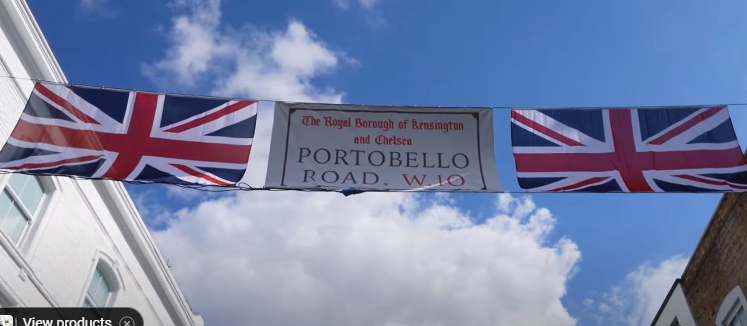but I do have a warning for you. London is not a very accessible city.
Hello from London. I'm AKIB, a disabled Londoner who's lived here for over 27 years and spent all of my time in the best spots to hang out in London.
the city is old and our infrastructure is old, and the powers that be haven't done a great job at updating it for the people that need it.

So I'm going to let you in on my best tips at having a great time in London as a wheelchair user, even though it is hard to get around.
We also use words like accessible, too. So you’ll often see disabled parking or blue badge parking or disabled toilet or accessible toilet. The color for disability is blue.
All right, we’ll start with the big one, travel.
Picture the scene. You’re on the plane, taxi it on the runway, ready to start your London adventure.
What now?
You need to book assistance to get on and off the plane in advance with your airline. Different airlines have different protocols, but generally, Virgin is considered one of the better airlines to travel with, although everybody has a different opinion. We suggest booking assistance when you book your tickets to make the experience as seamless and stress-free as possible. But you can let your airline know up to 48 hours before you travel.
your airline will pass you to the ground team when you disembark off the plane. They will help you to passport control and customs via a buggy or a wheelchair, depending on your needs. They’ll also help you find the accessible toilets. If you’re being a When you’re escorted, you’ll be taken to a dedicated accessible passport lane. And if you prefer to travel independently, the passport gates and counters are generally wheelchair accessible at UK Airport.

But check on the website with the airport that you’re arriving at for more information. If you don’t want an escort but do have access needs,
Here’s a tip for you. In the UK,
we have a scheme run by hidden disabilities called the Sunflower Lanyard. You might have it in your country now, too.
Basically, this is a lanyard with sunflowers on it that acts as an easy way to let people know that you have access needs or may need other adaptations. You You don’t need to have a hidden disability to wear one. Anyone with access needs can pick one up. You also don’t need to prove that you need one in order to have one.
You can get them for free from most assistance desks in UK airports, as well as supermarkets like Sainsbury’s and Marks & Spencers. Wearing this lanyard is a great way of alerting staff that you might need a bit of extra time or space as you travel through the airport.
the good news for your stress levels is that London’s major airports like Heathrow and Gatwick generally have step-free options to travel into central London.
The Elizabeth Line runs from Heathrow and is a totally step-free The Gatwick Express is the same.
If you’re traveling on the Gatwick Express,

it’s important to know the Victoria station is not entirely set free, so you may need to ask for access assistance once you arrive at the station. You can book assisted travel on the Gatwick Express by calling or emailing them up to 2 hours before your journey.
You can also get a black taxi from the airport to your hotel, which are wheelchair accessible but fairly pricey. Although we have had reports from some viewers that some power chairs do not fit in black taxis. If your is on the larger side, it might be worth checking the sizing with TFL. We’ll put rough dimensions on the screen now. In terms of Uber, they do offer some accessible options, but not that many, and it is not reliable. We give our opinions on using Uber to travel from airports in these ARTICLE.
Tube accessibility in London is pretty rough. It sucks to say, but only around one-third of London’s tube system is accessible to wheelchair users. Tfl, that’s transport for London, the people who manage London’s transport, publish a map of step three stations that looks like this. Fair warning, it’s pretty complicated.
When a station uses ramps, it’s helpful to book in advance. You can do this using an app called
“Passenger Assistance”
although you can turn up and find a staff member to assist you.
You don’t have to book assistance for mini ramps, but you’ll have to ask for assistance at the station, and that takes time. Boarding ramps also have a weight limit of around 300 kilograms, so 47 stone, for you, your chair, and anyone else assisting you. So these stations may not be fully accessible for everyone. The tube carriers themselves are only accessible at certain entrances. These are marked on a platform like this.
However, during busy periods, they can be difficult to find. They’ve changed this with the Elizabeth Line to make it clearer, where you can now find wheelchair friendly doors using the overhead signs, floor signs, and on the doors. You might notice some big stations for tourists here that aren’t accessible for wheelchair users like Piccadilly Circus, Leicester Square, Covent Garden, and Camden. So be aware when planning your trip and look for wheelchair accessible alternatives.
Generally, the Northern Line and Metropolitan Line have the fewest step-free stations, and the Elizabeth Line is the best. It’s step-free at all stations. Something to consider if you’re booking your accommodation. If this is all bonkers confusing, City A taxi mapper has a route calculation for people who need step-free access.

Although TFL run services will have the most accurate and up-to-date information.
Google Maps does not show step-free access options.
TfL also has a Twitter where they publish real-time information about broken down lifts, and temporarily inaccessible stations.
A tip here,
if there’s a broken lift and no alternative accessible route, TFL has to pay for a taxi for you. Ask the station staff to book this for you.
But the biggest tip I can give is that all London busses are step free. As a wheelchair user or somebody with limited mobility, the bus is such a good way to be able to get around the city and do some sightseeing at the same time.
A few other things to know about public transport. Both the tube and busses will have seats with signs that look like this. If you’re non-disabled and don’t need a seat, please reserve these for people who find standing more difficult. Non-disabled people who sit in these seats are expected to be asked to give up their seat, so don’t be afraid to ask to sit if you need to.
Tube stations generally don’t have toilets for everyone, but you can also get a radar key to be able to access accessible toilets.

To do this, contact Disability Rights UK, who will be able to get a key sent to your hotel for a small fee. If you need assistance for sight loss, ask for a TFL staff member at the information desk when you arrive at a station.
hacks for visiting
They can offer you assistance on and off the train and arrange for you to get assistance at your destination. A quick side note here is that guide dogs and registered assistance animals are welcome in all transport, stores, and other areas in the UK. You’ll need certification to get them into the country, but we’ll never need to show this when entering an establishment.
The only place they’re not allowed is in an operating room or areas where it might be dangerous. This doesn’t apply to emotional support animals, though. They’ll be allowed on public transport, but not in shops, restaurants, or attractions. Visiting a new city can be super overwhelming, so we’ve designed a free guide to help you learn everything a first-time visitor needs to know before visiting London.
You will learn how to get from your hotel to the airport,
how to get and spend the currency,
what you need to use London’s public transportation system, and how to plan for London’s weather, and much more.

Like with hotels, a lot of buildings in London are old and weren’t built with accessibility in mind. This means that they’re often difficult to navigate with mobility issues or visual impairments.
I want to suggest an app here that can help take the stress out of planning meals and shopping. It’s called Sociability. It’s a disabled-owned app that crowdsources information about establishment such as entrance and exit details, including steps and door widths, seating arrangements, including table and chair height and the path size between tables, table service versus bar service, air conditioning, bathrooms, and sensory accommodations. You can also add your experiences to the app, which we recommend you do.
You might be getting the theme here with the Londoners’ Old Chat, but it’s also true when it comes to streets and sidewalks. Many old streets don’t have drop curves, meaning that wheelchair users have to use the roads. Sidewalks can also be cracked or cobbled, which can be a falling risk, and there can be very limited seating when out and about
END




